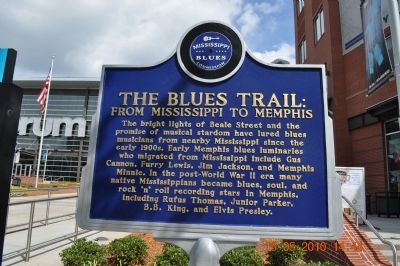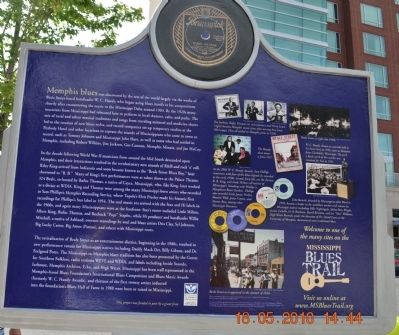Downtown Memphis in Shelby County, Tennessee — The American South (East South Central)
The Blues Trail From Mississippi to Memphis
(Reverse Side):
Memphis blues was discovered by the rest of the world largely via the works of Beale Street-based bandleader W.C. Handy, who began using blues motifs in his compositions shortly after encountering the music in the Mississippi Delta around 1903. By the 1920s musicians from Mississippi had relocated here to perform in local theaters, cafes, and parks. The mix of rural and urban musical traditions and songs from traveling minstrel and medicine shows led to the creation of new blues styles, and record companies set up temporary studios at the Peabody Hotel and other locations to capture the sounds of Mississippians who came to town to record, such as Tommy Johnson and Mississippi John Hurt, as well as some who had settled in Memphis, including Robert Wilkins, Jim Jackson, Gus Cannon, Memphis Minnie, and Joe McCoy.
In the decade following World War II musicians from around the Mid South descended upon Memphis, and their interactions resulted in the revolutionary new sounds of R&B and rock ‘n’ roll.
Riley King arrived from Indianola and soon became known as the “Beale Street Blues Boy,” later shortened to “B.B.” Many of King’s first performances were at talent shows at the Palace Theater, 324 Beale, co-hosted by Rufus Thomas, a native of Cayce, Mississippi, who, like King, later worked as a deejay at WDIA. King and Thomas were among the many Mississippi-born artists who recorded at Sam Phillip’s Memphis Recording Service, where Tupelo’s Elvis Presley made his historic first recording for Phillip’s Sun label in 1954. The soul music era arrived with the Stax and Hi labels in the 1960s, and again many Mississippians were at the forefront: Stax’s roster included Little Milton, Albert King, Rufus Thomas, and Roebuck “Pops” Staples, while Hi producer and bandleader Willie Mitchell, a native of Ashland, oversaw recordings by soul and blues artists Otis Clay, Syl Johnson, Big Luck Carter, Big Amos (Patton), and others with Mississippi roots.
The revitalization of Beale Street as an entertainment district, beginning in the 1980s, resulted in new performance venues for Mississippi natives including Daddy Mack Orr, Billy Gibson, and Dr. Feelgood Potts. The Mississippi-to-Memphis blues tradition has also been promoted by the Center for Southern Folklore, radio stations WEVL and WDIA, and labels including Inside Sounds, Icehouse, Memphis Archives, Ecko, and High Water. Mississippi has been well represented in the Memphis-based Blues Foundation’s International Blues Competition and Blues Music Awards (formerly W.C. Handy Awards), and thirteen of the first twenty artists inducted into the foundation’s Blues Hall of Fame in 1980 were born or raised in Mississippi. Jim Jackson, Rufus Thomas (at microphone), and Furry Lewis (right) became Memphis music icons after moving here from Mississippi. They all settled in Memphis prior to 1920.
Erected 2003 by Mississippi Blues Commission. (Marker Number 72.)
Topics and series. This historical marker is listed in these topic lists: African Americans • Arts, Letters, Music. In addition, it is included in the Mississippi Blues Trail series list. A significant historical year for this entry is 1903.
Location. 35° 8.316′ N, 90° 3.135′ W. Marker is in Memphis, Tennessee, in Shelby County. It is in Downtown Memphis. Marker is at the intersection of 3rd Street and Lt George W Lee Avenue, on the right when traveling north on 3rd Street. In front of Fedxforum and across road from Gibson Retail Store. Touch for map. Marker is in this post office area: Memphis TN 38103, United States of America. Touch for directions.
Other nearby markers. At least 8 other markers are within walking distance of this marker. Lung Kong Tin Yee Association / The Chinese Exclusion Act of 1882 (within shouting distance of this marker); Beale Street Historic District (about 300 feet away, measured in a direct line); Hooks Brothers Photography (about 400 feet away); Ida B. Wells (about 400 feet away); Beale Street #3 (about 500 feet away); Beale Street #4 (about 500 feet away); Pee Wee Saloon (about 500 feet away); Benjamin Franklin Booth (about 500 feet away). Touch for a list and map of all markers in Memphis.
More about this marker. On the reverse, to the right side, is a collection of photos. At the top are photos of Jim Jackson, Rufus Thomas, Furry Lewis who Became Memphis music icons after moving here from Mississippi. They all settled in Memphis prior to 1920. In the upper right is a photo of Beale Street at night, late 1930s. In the right center is a photo of W.C. Handy, shown at a parade held in his honor here in 1953, came to Memphis from Clarksdale, Mississippi. The park a block north of this marker was renamed for him in 1931. The cover of Handy sheet music from 1917 is beside the photo. In the center is a photo captioned, At the 2003 W.C. Handy Awards, Sam Phillips reminisces with four of the blues legends he recorded in the early 1950s. Seated, from left, are Ike Turner, B.B. King, and Little Milton (all natives of Mississippi). Standing with Phillips is Memphian Rosco Gordon. Phillips also recorded Little Junion Parker, Howlin' Wolf, James Cotton, and Doctor Ross, among other Mississippi bluesmen. Beside photos of various records is the caption, Ecko Records, founded by Mississippian John Ward in 1995, became a leader in the soul/blues market with releases by Mississippi natives including Ollie Nightingale, Sheba Potts-Wright, Denise LaSalle, O.B. Buchana, David Brinston, and Lee "Shot" Williams. High Water Records, under the direction of Dr. David Evans at the University of Memphis, documented more traditional blues. At the bottom of the reverse side is a photo of Beale Street as it appeared in the summer of 1944.
Credits. This page was last revised on February 7, 2023. It was originally submitted on July 1, 2010, by Sandra Hughes Tidwell of Killen, Alabama, USA. This page has been viewed 1,699 times since then and 58 times this year. Last updated on May 3, 2015, by J. Makali Bruton of Accra, Ghana. Photos: 1, 2, 3. submitted on July 1, 2010, by Sandra Hughes Tidwell of Killen, Alabama, USA. • Bill Pfingsten was the editor who published this page.


